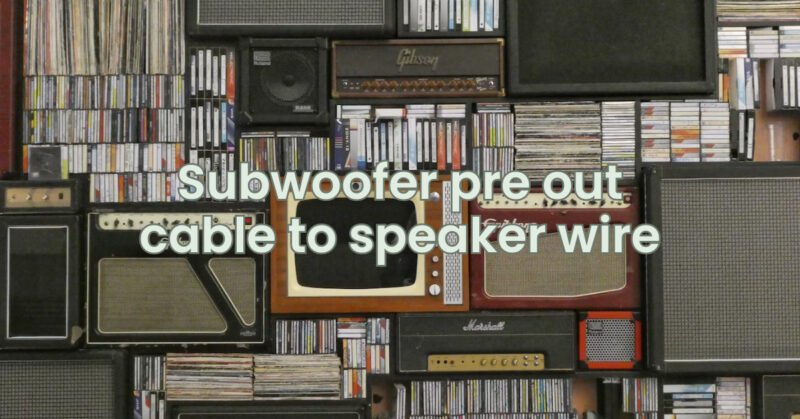Subwoofer Pre Out connections on audio receivers or amplifiers provide a dedicated output for connecting subwoofers. However, in certain setups, you may need to connect the Subwoofer Pre Out cable to speaker wire instead of using a traditional subwoofer cable. In this article, we will provide a step-by-step guide on how to connect a Subwoofer Pre Out cable to speaker wire, allowing you to integrate a subwoofer into your audio system for enhanced bass integration.
Step 1: Gather the Required Equipment:
To connect the Subwoofer Pre Out cable to speaker wire, you will need the following equipment:
- Audio receiver or amplifier with a Subwoofer Pre Out connection.
- Subwoofer with speaker wire inputs.
- Speaker wire with appropriate gauge and length.
- Wire strippers and/or wire cutters.
Step 2: Identify the Subwoofer Pre Out Connection:
Locate the Subwoofer Pre Out connection on the back panel of your audio receiver or amplifier. It is typically labeled as “Sub Out” or “Subwoofer Out.” The Subwoofer Pre Out connection consists of one or two RCA jacks, usually color-coded as white for the left channel and red for the right channel.
Step 3: Power Off and Make Connections:
Before making any connections, ensure that both the audio receiver/amplifier and the subwoofer are powered off and unplugged from the electrical outlet. This step is crucial to avoid any potential electrical damage or mishaps.
Cut two lengths of speaker wire, ensuring they are long enough to reach from the Subwoofer Pre Out on the receiver to the subwoofer’s speaker wire inputs.
Strip approximately 1/2 inch of insulation from each end of the speaker wire using wire strippers or wire cutters, exposing the bare wire.
Connect one end of the speaker wire to the positive (+) terminal of the left channel Subwoofer Pre Out. Twist the exposed wire strands together and ensure a secure connection. Repeat the process for the negative (-) terminal.
Next, connect the other end of the speaker wire to the corresponding positive (+) and negative (-) terminals on the subwoofer’s speaker wire inputs. Twist the exposed wire strands together and ensure a secure connection.
Step 4: Power On and Adjust Settings:
After making the connections, power on both the audio receiver/amplifier and the subwoofer.
Access the audio receiver or amplifier’s menu or settings and locate the subwoofer output settings. Ensure that the subwoofer output is enabled or set to “On.” Adjust the subwoofer volume or level control to a reasonable starting point.
Step 5: Fine-Tune the Subwoofer:
To optimize the subwoofer’s performance, experiment with the audio receiver or amplifier’s equalizer settings. Some models offer specific subwoofer controls, such as crossover frequency and phase adjustment. These settings can help fine-tune the integration of the subwoofer with the main speakers for optimal bass performance.
Step 6: Test and Enjoy:
Play audio content that contains prominent low-frequency elements, such as music with deep bass or movies with impactful sound effects.
Listen carefully to the audio playback and make adjustments to the subwoofer volume or level control as necessary to achieve the desired bass balance. Aim for a bass response that complements the overall sound, enhancing the listening experience without overpowering the rest of the audio.
Conclusion:
Connecting a Subwoofer Pre Out cable to speaker wire allows you to integrate a subwoofer into your audio system for enhanced bass integration. By following the step-by-step guide outlined in this article, you can confidently connect the Subwoofer Pre Out cable to speaker wire, enabling you to experience deep, impactful bass that brings your audio to life. Remember to power off all components before making connections, adjust the subwoofer settings on the audio receiver or amplifier, and fine-tune the subwoofer’s controls for optimal bass integration. With the correct setup and adjustments, you can enjoy rich, powerful bass reproduction that enhances your overall audio experience.


